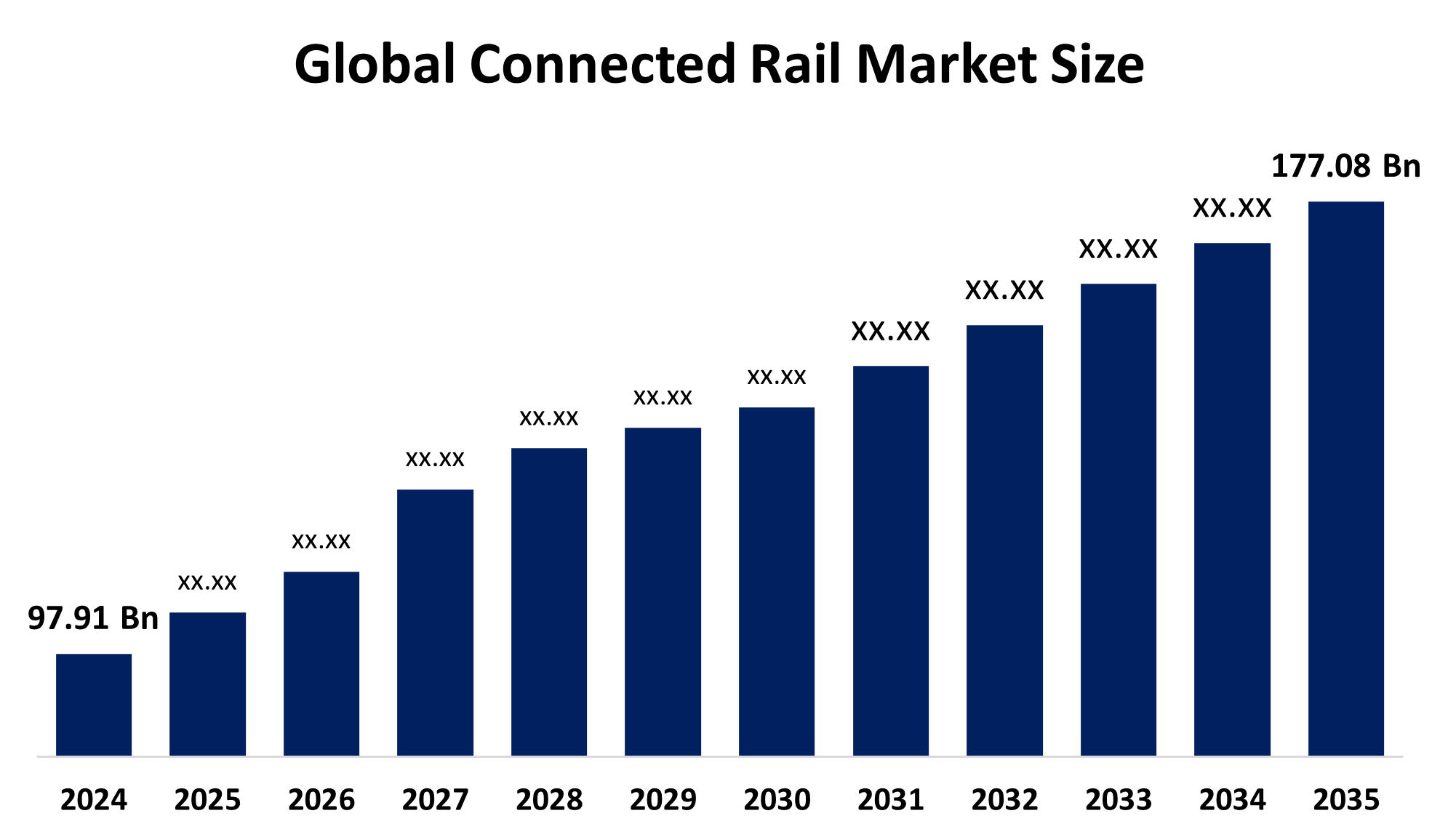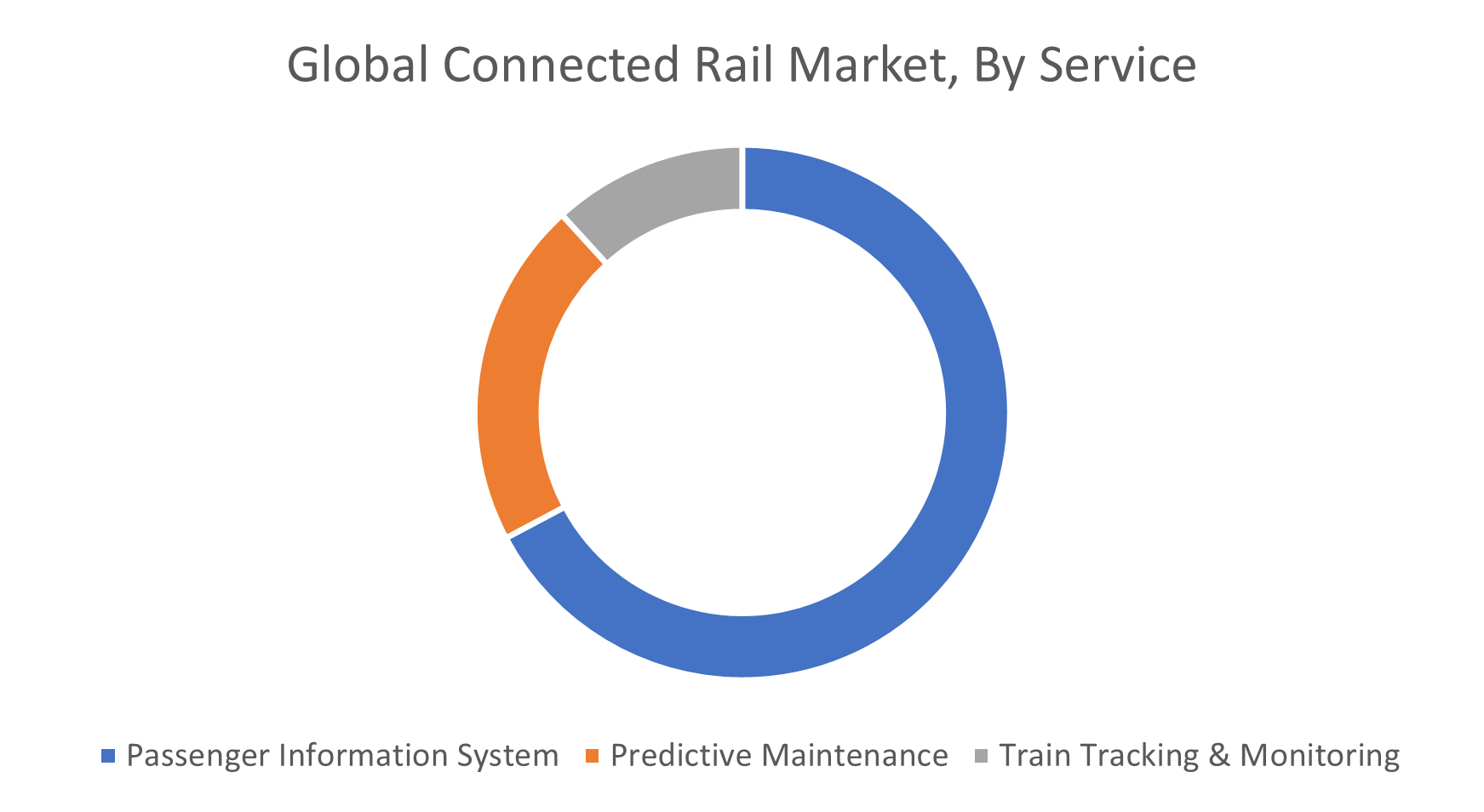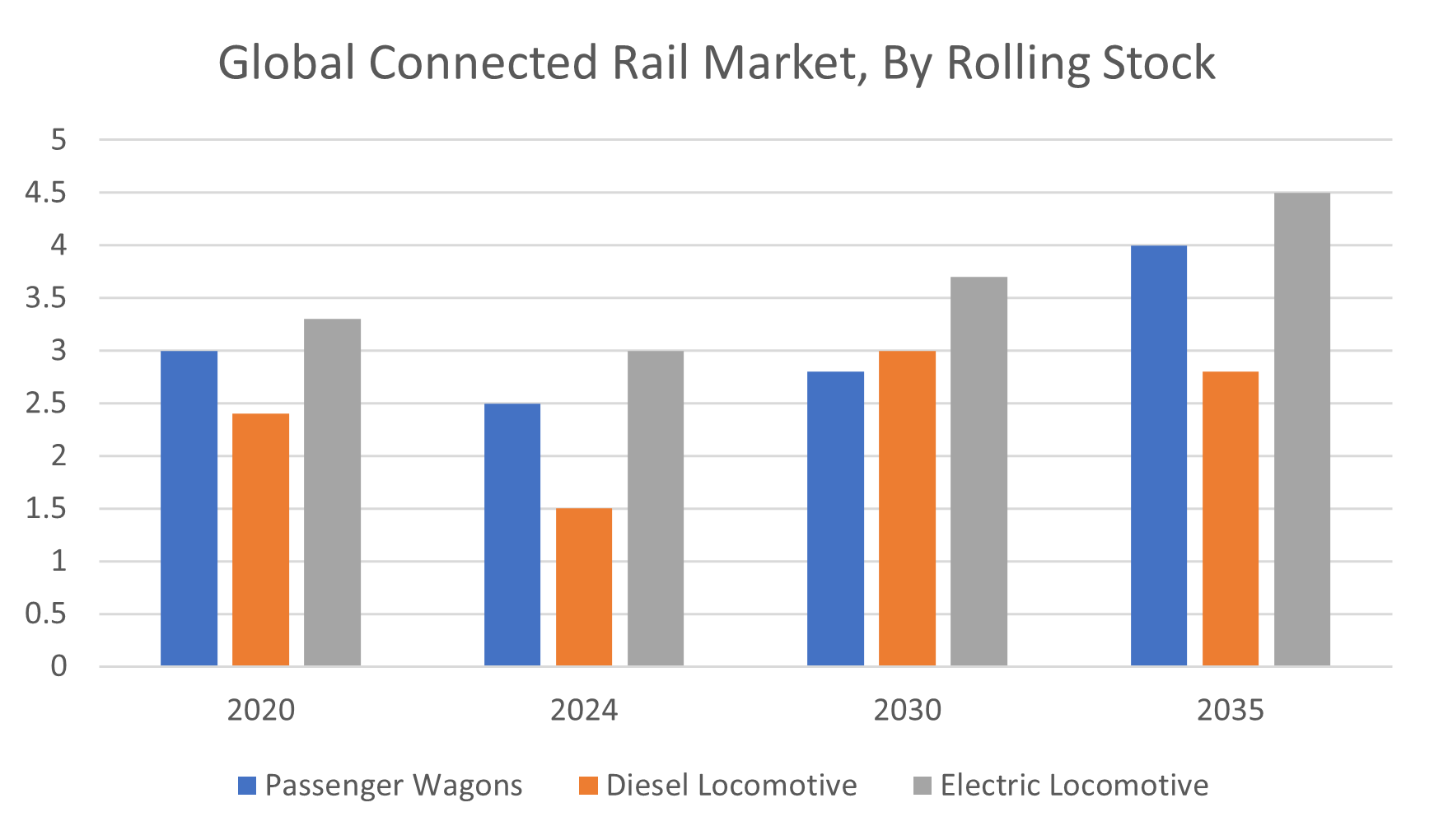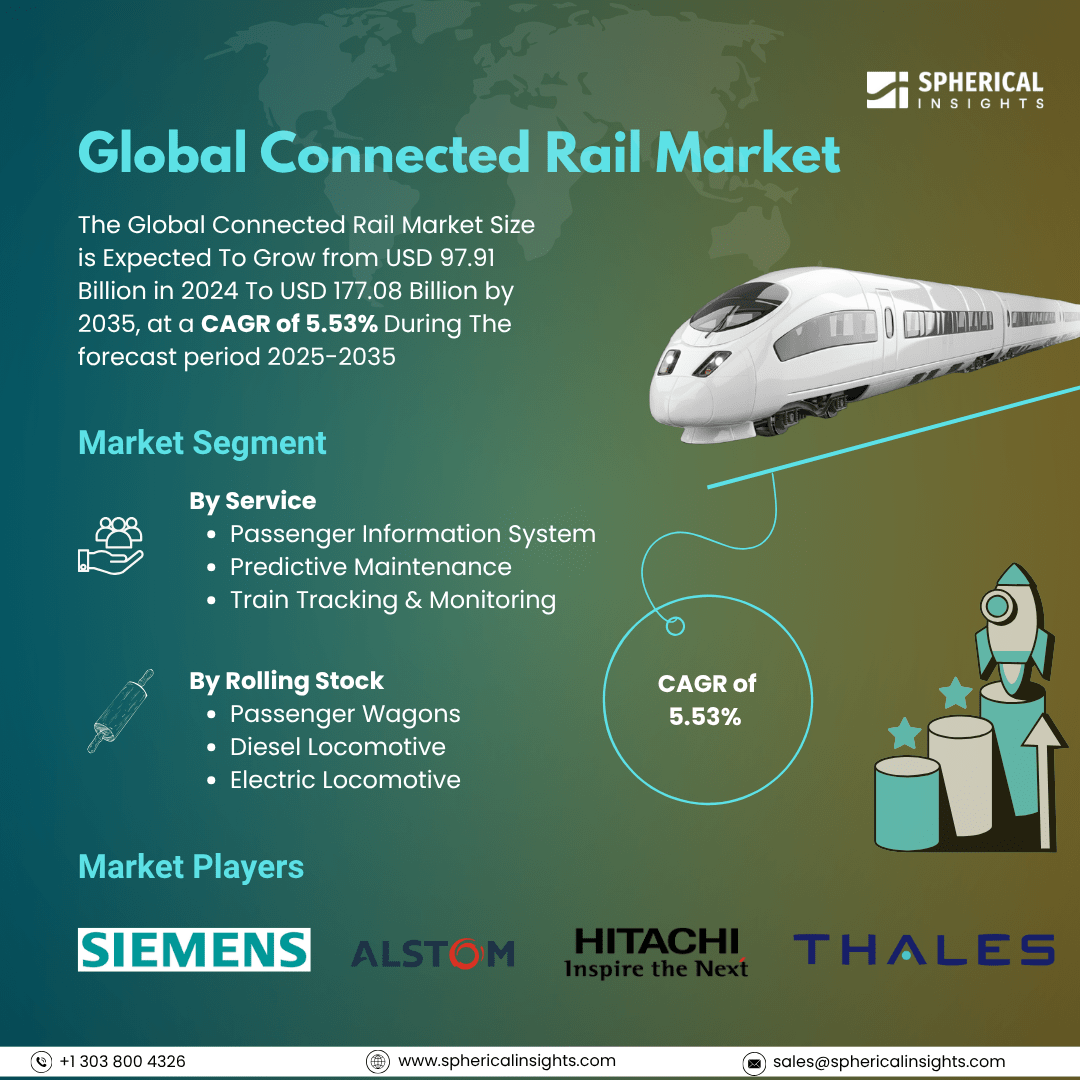Global Connected Rail Market Insights Forecasts To 2035
- The Global Connected Rail Market Size Was Estimated at USD 97.91 Billion in 2024
- The Market Size is Expected to Grow at a CAGR of around 5.53% from 2025 to 2035
- The Worldwide Connected Rail Market Size is Expected to Reach USD 177.08 Billion by 2035
- Asia Pacific is expected to grow the fastest during the forecast period.

Connected Rail Market
The global connected rail market involves the integration of advanced communication and digital technologies within railway systems to enable real-time data exchange, improve operational efficiency, and enhance passenger services. It includes solutions like Internet of Things (IoT) applications, onboard connectivity, automated fare collection, predictive maintenance, and advanced signaling systems. These technologies allow seamless communication between trains, infrastructure, and control centers, resulting in safer, more reliable, and efficient rail operations. Major industry players such as Siemens, Alstom, Hitachi, and Huawei are leading the development and deployment of innovative connected rail solutions. This market is driving the transformation of traditional rail networks into intelligent, data-driven systems designed to meet future transportation needs by improving mobility, safety, and overall system performance.
Attractive Opportunities in the Connected Rail Market
- Growing urban populations drive demand for integrated, seamless transportation systems. Connected rail plays a key role in enabling efficient, multimodal transit networks that improve mobility and reduce congestion.
- Connected rail supports energy-efficient, low-emission transport solutions, aligning with global climate goals and encouraging investments in sustainable infrastructure.
- Partnerships between tech providers and rail operators open new revenue streams, such as Mobility-as-a-Service (MaaS), integrating rail with other transport modes for enhanced convenience.
Global Connected Rail Market Dynamics
DRIVER: Connected technologies enable real-time monitoring and data analytics
Connected technologies enable real-time monitoring and data analytics, allowing for predictive maintenance that reduces downtime and prevents accidents. Governments and rail operators are investing heavily in smart infrastructure to modernize aging networks and improve service reliability. Additionally, rising passenger expectations for seamless connectivity, such as onboard Wi-Fi and real-time travel information, are pushing the adoption of connected rail solutions. The integration of Internet of Things (IoT), Artificial Intelligence (AI), and 5G technology further accelerates market growth by enabling faster communication, automation, and improved decision-making. Sustainability initiatives are also fueling investments in connected rail, as these technologies help optimize energy consumption and reduce carbon footprints. Together, these factors are driving the rapid expansion of connected rail systems worldwide, transforming traditional railways into more intelligent and efficient transportation networks.
RESTRAINT: Integration challenges with existing legacy rail infrastructure also slow down adoption
High implementation and maintenance costs of advanced connected rail technologies can be a significant barrier, especially for developing countries or operators with limited budgets. Integration challenges with existing legacy rail infrastructure also slow down adoption, as upgrading or retrofitting systems requires substantial investment and technical expertise. Additionally, concerns over data security and privacy arise due to the increased connectivity and reliance on digital communication, raising risks of cyberattacks on critical rail infrastructure. Regulatory complexities and the lack of standardized protocols across regions further complicate the deployment of connected rail solutions. Moreover, the need for skilled personnel to manage and operate these sophisticated systems can limit market growth, as workforce training and development require time and resources.
OPPORTUNITY: The rise of smart cities and urbanization creates a growing need for integrated transportation
The rise of smart cities and urbanization creates a growing need for integrated transportation networks, where connected rail systems can play a crucial role in seamless multimodal transit solutions. Advancements in edge computing and big data analytics offer opportunities to enhance real-time decision-making and operational efficiency in rail networks. Collaboration between technology providers and rail operators opens avenues for innovative business models, such as mobility-as-a-service (MaaS), which can increase revenue streams. The increasing focus on sustainability and reducing carbon emissions encourages investments in connected rail as a green alternative to road transport. Additionally, emerging technologies like augmented reality (AR) and virtual reality (VR) can improve training and maintenance processes for rail staff. Expanding connectivity to freight rail also offers potential for optimized logistics and supply chain management, creating further growth prospects within the connected rail ecosystem.
CHALLENGES: The complexity of integrating diverse technologies and systems from multiple vendors
One major challenge is the complexity of integrating diverse technologies and systems from multiple vendors, which can lead to interoperability issues and hinder seamless communication across the network. Ensuring consistent and reliable connectivity in remote or underground rail segments remains difficult due to physical and technical limitations. Additionally, managing and analyzing the massive volume of data generated by connected rail systems requires robust IT infrastructure and advanced analytics capabilities. The evolving regulatory landscape can also pose challenges, as compliance with varying standards and policies across countries may delay project implementations. Resistance to change within established rail organizations, including the need for workforce retraining and adaptation to new workflows, can slow down digital transformation efforts.
Global Connected Rail Market Ecosystem Analysis
The global connected rail market ecosystem consists of key stakeholders including technology providers, rail operators, system integrators, telecom companies, and regulatory authorities. Technology providers develop IoT devices, sensors, communication networks, and data analytics platforms essential for connected rail solutions. Rail operators and infrastructure owners implement these technologies to improve safety, efficiency, and passenger experience. System integrators customize and deploy tailored solutions, while telecom companies ensure reliable real-time data transmission through advanced network infrastructure. Regulatory bodies establish standards and compliance requirements to guarantee interoperability and security. Supporting services like cybersecurity, maintenance, and workforce training further enable sustainable and secure connected rail operations worldwide.
Based on the service, the passenger information system segment held the largest market share and is expected to grow at a significant CAGR over the forecast period

The passenger information system segment growth is driven by increasing demand for real-time travel updates, improved passenger communication, and enhanced overall travel experience. Passenger information systems provide timely notifications about schedules, delays, and emergencies, helping to increase operational efficiency and passenger satisfaction. As rail networks continue to modernize, investment in advanced, connected passenger information solutions is expected to rise, further expanding this segment’s dominance in the connected rail market.
Based on the rolling stock, the electric locomotives segment is expected to register the fastest CAGR over the forecast period

The growth is driven by increasing adoption of electric locomotives due to their energy efficiency, lower emissions, and compatibility with smart technologies. Connected solutions enable better monitoring, predictive maintenance, and real-time data exchange for electric locomotives, enhancing performance and reducing downtime. As rail operators prioritize sustainable and technologically advanced transportation, the demand for connected electric locomotives is projected to accelerate rapidly, contributing significantly to the overall growth of the connected rail market.
North America is anticipated to hold the largest market share of the connected rail market during the forecast period
North America is anticipated to hold the largest market share in the connected rail market during the forecast period. This dominance is attributed to the region’s well-established rail infrastructure, significant investments in modernization, and strong adoption of advanced technologies such as IoT, AI, and 5G in rail systems. Additionally, government initiatives focused on improving transportation safety, efficiency, and passenger experience further drive market growth. The presence of major industry players and increasing demand for smart and connected solutions in both passenger and freight rail segments also contribute to North America’s leading position in the connected rail market.
Asia Pacific is expected to grow at a significant CAGR in the connected rail market during the forecast period
Asia Pacific is expected to grow at a significant CAGR in the connected rail market during the forecast period. Rapid urbanization, expanding rail networks, and increased government investments in smart transportation infrastructure are key factors driving this growth. The region’s focus on upgrading traditional rail systems with advanced technologies such as IoT, AI, and real-time monitoring is accelerating the adoption of connected rail solutions. Additionally, rising demand for efficient passenger services and freight management, coupled with growing industrialization, supports the region’s robust market expansion, making Asia Pacific one of the fastest-growing markets in the connected rail industry.
Recent Development
- In September 2024, Siemens Mobility unveiled Egypt's first Velaro high-speed train at InnoTrans, Berlin. The train operates at speeds of 250 km/h and boasts improved passenger amenities and weather-proof technology, marking a significant milestone in Egypt’s ambitious 2,000 km rail plan.
- In April 2024, CSX Corporation unveiled its first hydrogen-powered locomotive, marking a significant milestone in sustainable freight transportation. This product launch is expected to drive innovation and expansion of their business.
Key Market Players
KEY PLAYERS IN THE CONNECTED RAIL MARKET INCLUDE
- Siemens Mobility
- Alstom
- Hitachi Rail
- Thales Group
- Huawei Technologies
- Bombardier Transportation (now part of Alstom)
- General Electric (GE Transportation)
- Cisco Systems
- Honeywell International
- Cisco Systems
- Nokia
- Others
Market Segment
This study forecasts revenue at global, regional, and country levels from 2020 to 2035. Spherical Insights has segmented the connected rail market based on the below-mentioned segments:
Global Connected Rail Market, By Service
- Passenger Information System
- Predictive Maintenance
- Train Tracking & Monitoring
Global Connected Rail Market, By Rolling Stock
- Passenger Wagons
- Diesel Locomotive
- Electric Locomotive
Global Connected Rail Market, By Regional Analysis
- North America
- Europe
- Germany
- UK
- France
- Italy
- Spain
- Russia
- Rest of Europe
- Asia Pacific
- China
- Japan
- India
- South Korea
- Australia
- Rest of Asia Pacific
- South America
- Brazil
- Argentina
- Rest of South America
- Middle East & Africa
- UAE
- Saudi Arabia
- Qatar
- South Africa
- Rest of the Middle East & Africa






